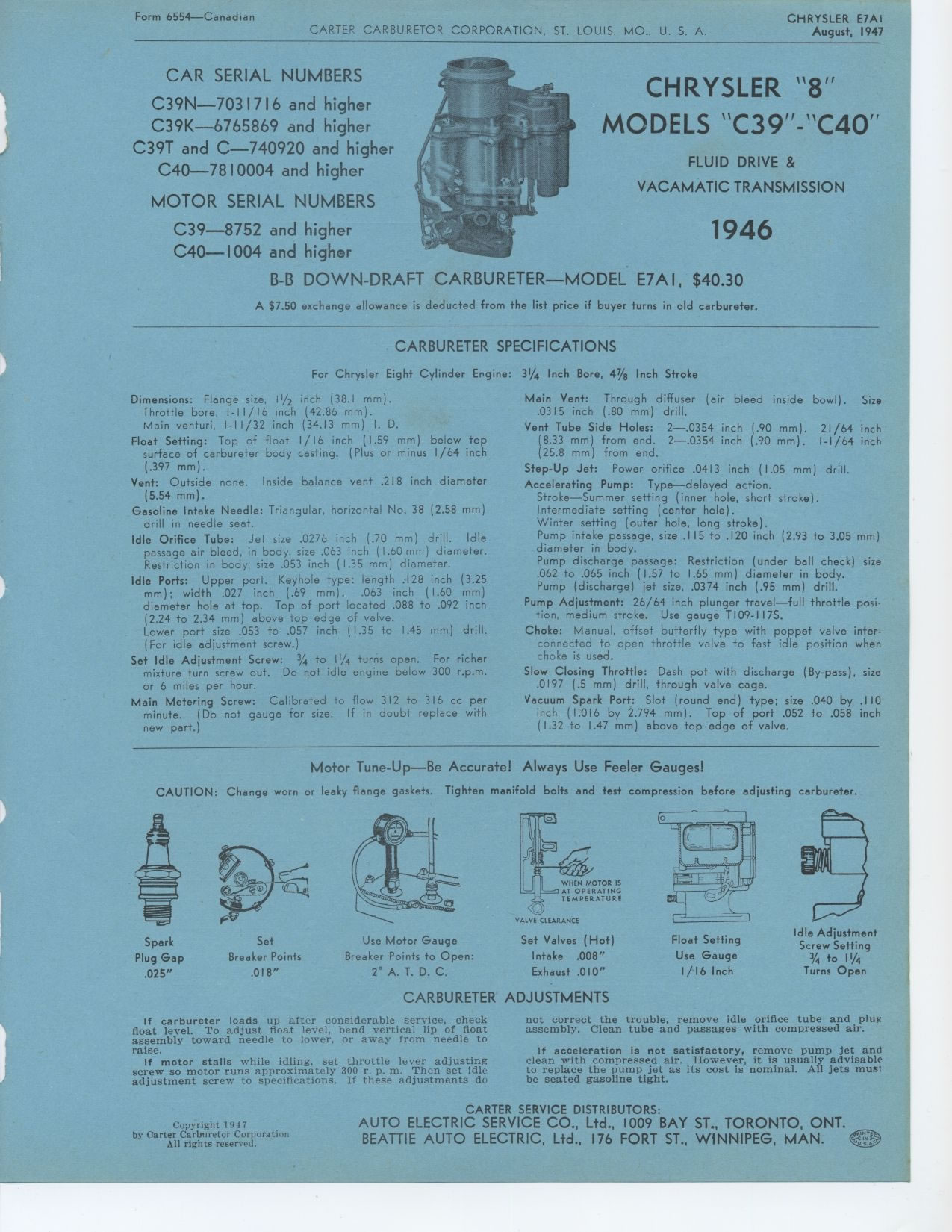Chrysler Old Carter Carburetors : CHRYSLER 8 MODELS C39 C40 FLUID DRIVE & VACAMATIC TRANSMISSION 1946Previous | Home | Next |
 |
Form 6554—Canadian
CAR SERIAL NUMBERS
C39N—7031716 and higher
C39K—6765869 and higher
C39T and C—740920 and higher
C40—7810004 and higher
MOTOR SERIAL NUMBERS
C39—8752 and higher C40—1004 and higher
CHRYSLER 8
MODELS C39 C40
FLUID DRIVE &
VACAMATIC TRANSMISSION
1946
B-B DOWN-DRAFT CARBURETER—MODEL E7AI, $40.30
A $7.50 exchange allowance is deducted from the list price if buyer turns in
old carbureter.
CARBURETER SPECIFICATIONS
For Chrysler Eight Cylinder Engine:
Dimensions: Flange size, 11/2 Throttle bore, 1-11/16 inch Main venturi, I-I
I/32 inch
Float Setting: Top of float surface of carbureter body (.397 mm).
Vent: Outside none. Inside balance vent .218 inch diameter (5.54 mm).
Gasoline Intake Needle: Triangular, horizontal No. 38 (2.58 mm) drill in needle
seat.
Idle Orifice Tube: Jet size .0276 inch (.70 mm) drill. Idle passage air bleed,
in body, size .063 inch (1.60 mm) diameter. Restriction in body, size .053
inch (1.35 mm) diameter.
Idle Ports: Upper port. Keyhole type: length .128 inch (3.25 mm); width .027
inch (.69 mm). .063 inch (1.60 mm) diameter hole at top. Top of port located
.088 to .092 inch (2.24 to 2.34 mm) above top edge of valve.
Lower port size .053 to .057 inch (1.35 to 1.45 mm) drill. (For idle adjustment
screw.)
Set Idle Adjustment Screw: 3/4 to 11/4 turns open. For richer mixture turn
screw out. Do not idle engine below 300 r.p.m. or 6 miles per hour.
Main Metering Screw: Calibrated to flow 312 to 316 cc per minute. (Do not gauge
for size. If in doubt replace with new part.)
31/4 Inch Bore, 47/8 Inch Stroke
Main Vent: Through diffuser (air bleed inside bowl). Size .0315 inch (.80
mm) drill.
Vent Tube Side Holes: 2—.0354 inch (.90 mm). 21/64 inch (8.33 mm) from
end. 2—.0354 inch (.90 mm). I-I/64 inch (25.8 mm) from end.
Step-Up Jet: Power orifice .0413 inch (1.05 mm) drill.
Accelerating Pump: Type—delayed action.
Stroke—Summer setting (inner hole, short stroke). Intermediate setting
(center hole).
Winter setting (outer hole, long stroke).
Pump intake passage, size .115 to .120 inch (2.93 to 3.05 mm) diameter in body.
Pump discharge passage: Restriction (under ball check) size .062 to .065 inch
(1.57 to 1.65 mm) diameter in body. Pump (discharge) jet size, .0374 inch (.95
mm) drill.
Pump Adjustment: 26/64 inch plunger travel—full throttle position, medium
stroke. Use gauge T109-117S.
Choke: Manual, offset butterfly type with poppet valve inter-connected to open
throttle valve to fast idle position when choke is used.
Slow Closing Throttle: Dash pot with discharge (By-pass), size .0197 (.5 mm)
drill, through valve cage.
Vacuum Spark Port: Slot (round end) type; size .040 by .110 inch (1.016 by
2.794 mm). Top of port .052 to .058 inch (1.32 to 1.47 mm) above top edge of
valve.
inch (38.1 mm).
(42.86 mm).
(34.13 mm) I. D.
1/16 inch (1.59 mm) below top casting. (Plus or minus 1/64 inch
Motor Tune-Up—Be Accurate! Always Use Feeler Gauges!
CAUTION: Change worn or leaky flange gaskets. Tighten manifold bolts and test
compression before adjusting carbureter.
Set
Breaker Points
.018"
Use Motor Gauge
Breaker Points to Open:
2° A. T. D.C.
VALVE CLEARANCE
Set Valves (Hot) Intake .008" Exhaust .010"
Float Setting Use Gauge 1/16 Inch
Idle Adjustment Screw Setting
¾ to 11/4 Turns Open
Spark Plug Gap .025"
CARBURETER ADJUSTMENTS
If carbureter loads up after considerable service, check float level. To adjust
float level, bend vertical lip of float assembly toward needle to lower, or
away from needle to raise.
If motor stalls while idling, set throttle lever adjusting screw so motor runs
approximately 300 r. p. m. Then set idle adjustment screw to specifications.
If these adjustments donot correct the trouble, remove idle orifice tube and
plug assembly. Clean tube and passages with compressed air.
If acceleration is not satisfactory, remove pump jet and clean with compressed
air. However, it is usually advisable to replace the pump jet as its cost is
nominal. All jets must be seated gasoline tight.
Copyright 1947